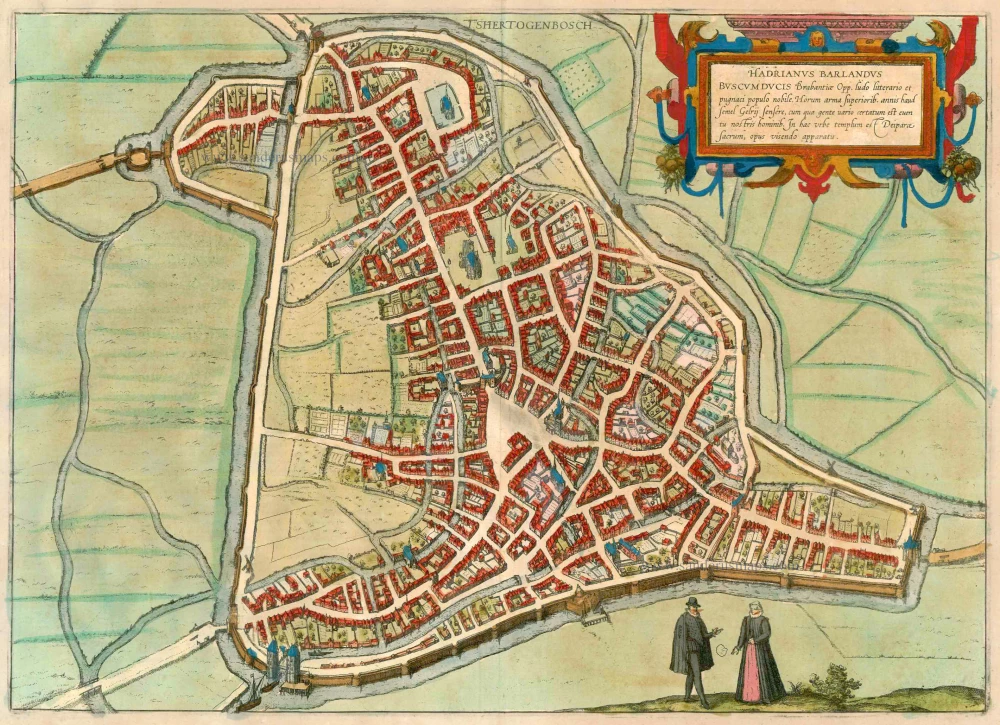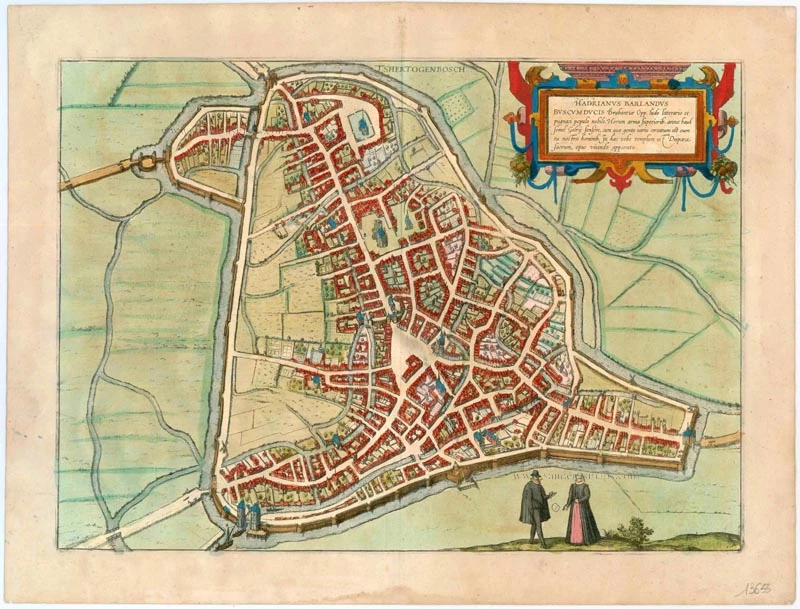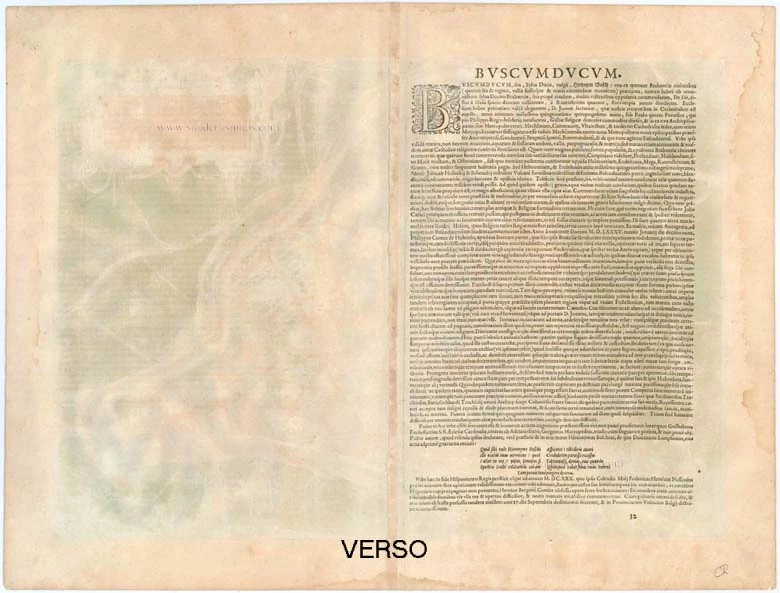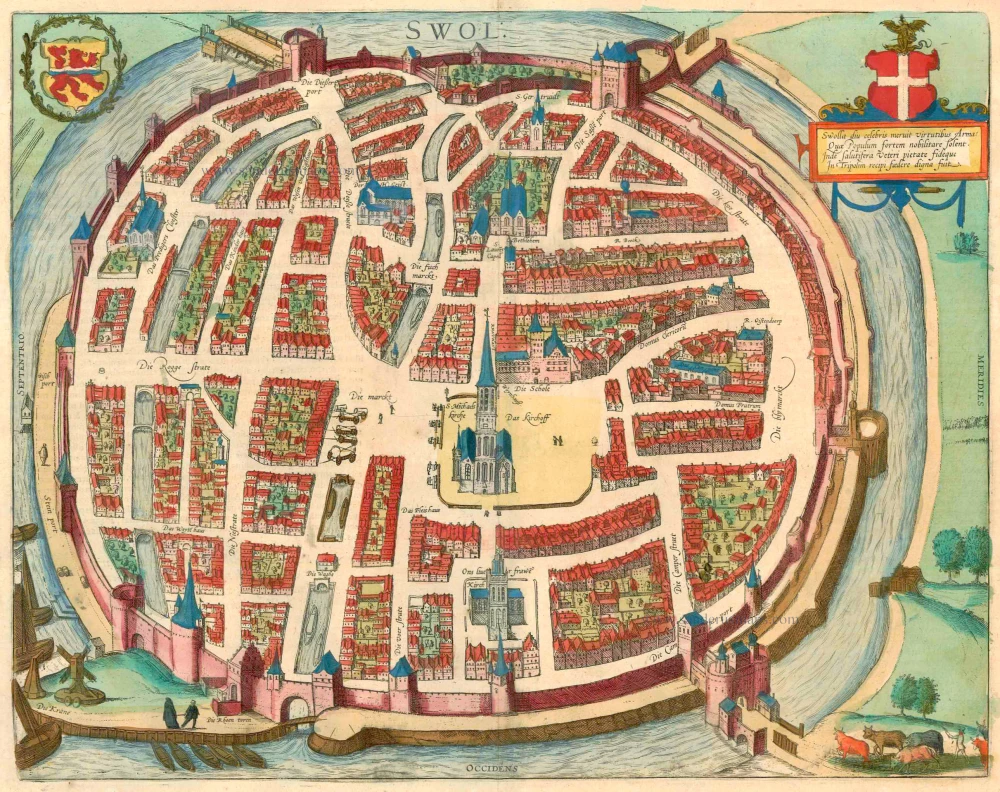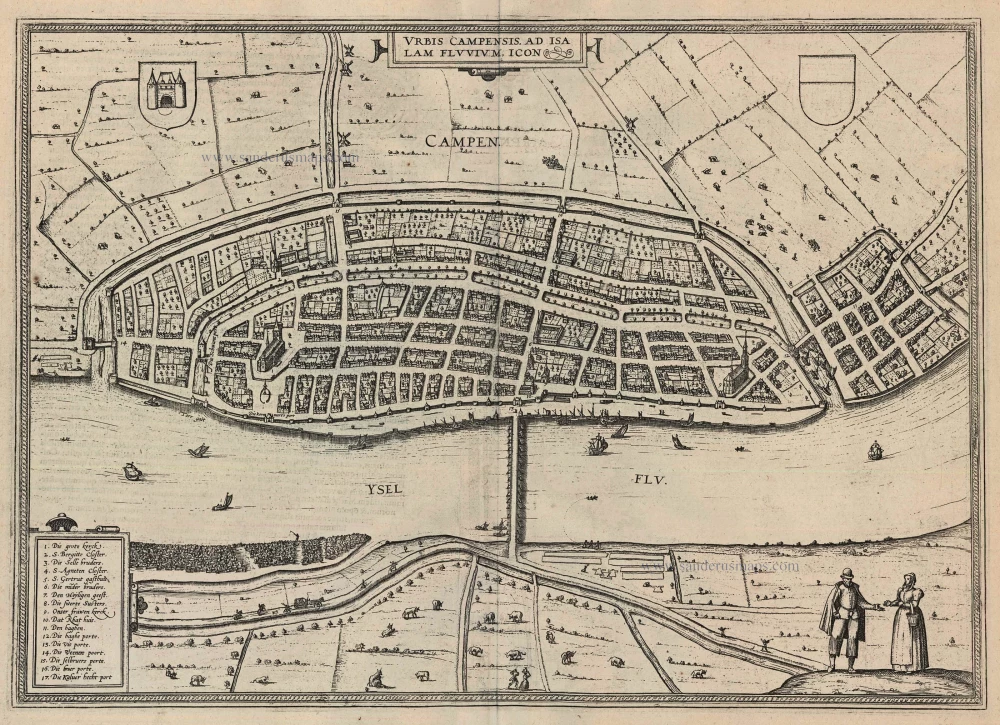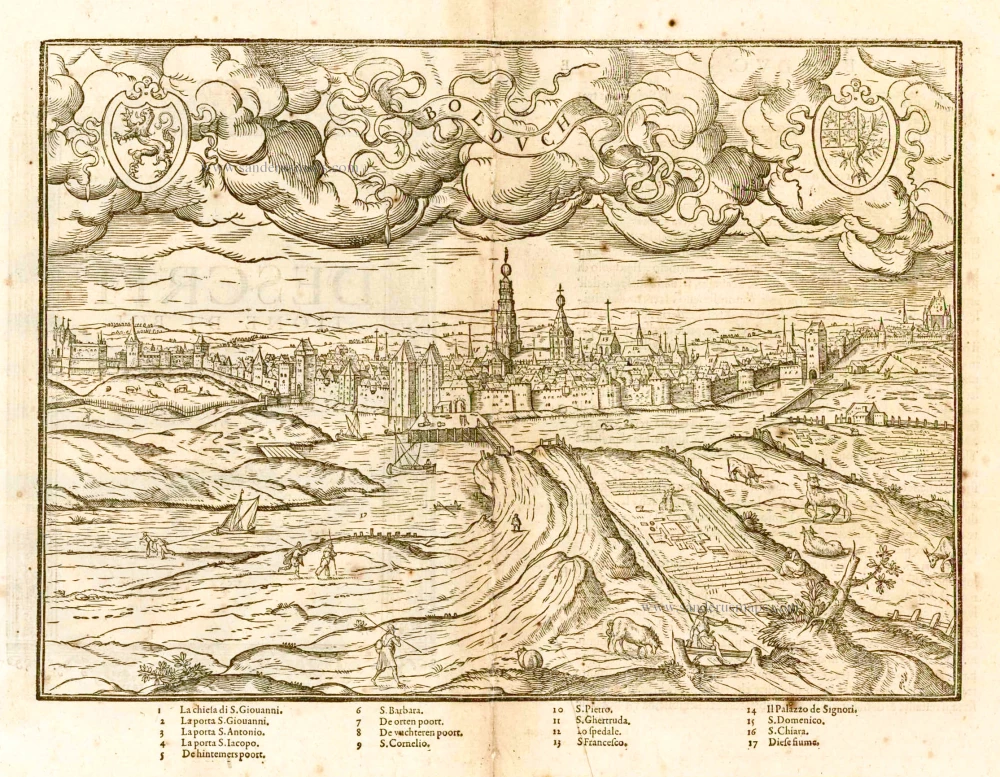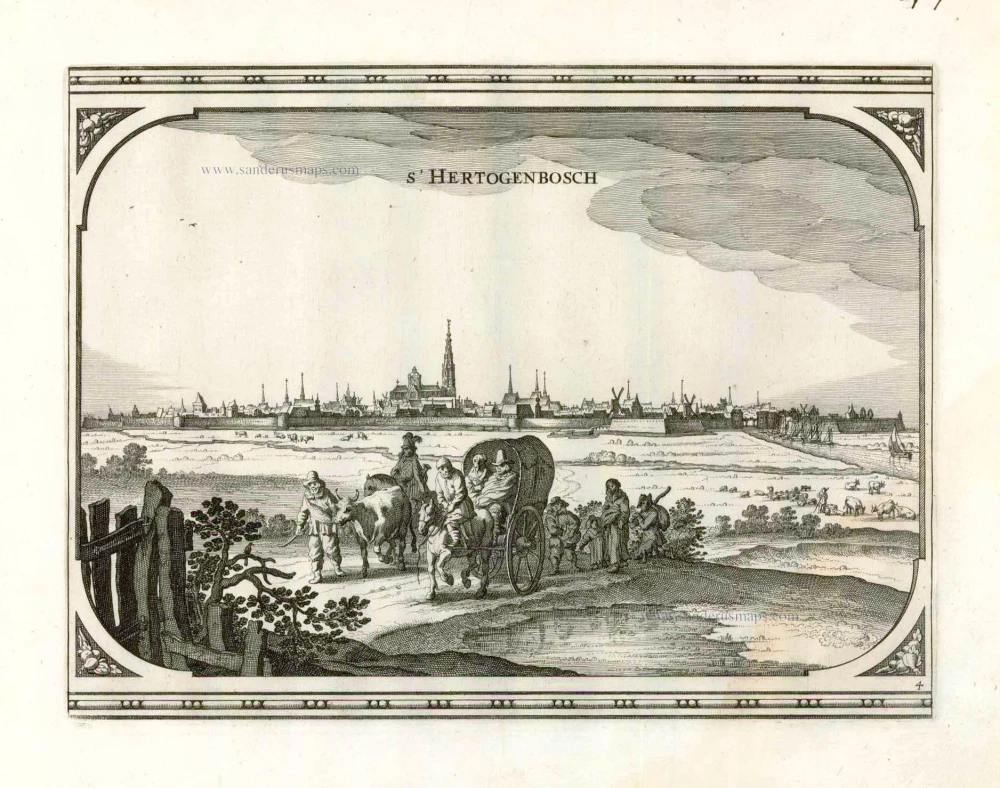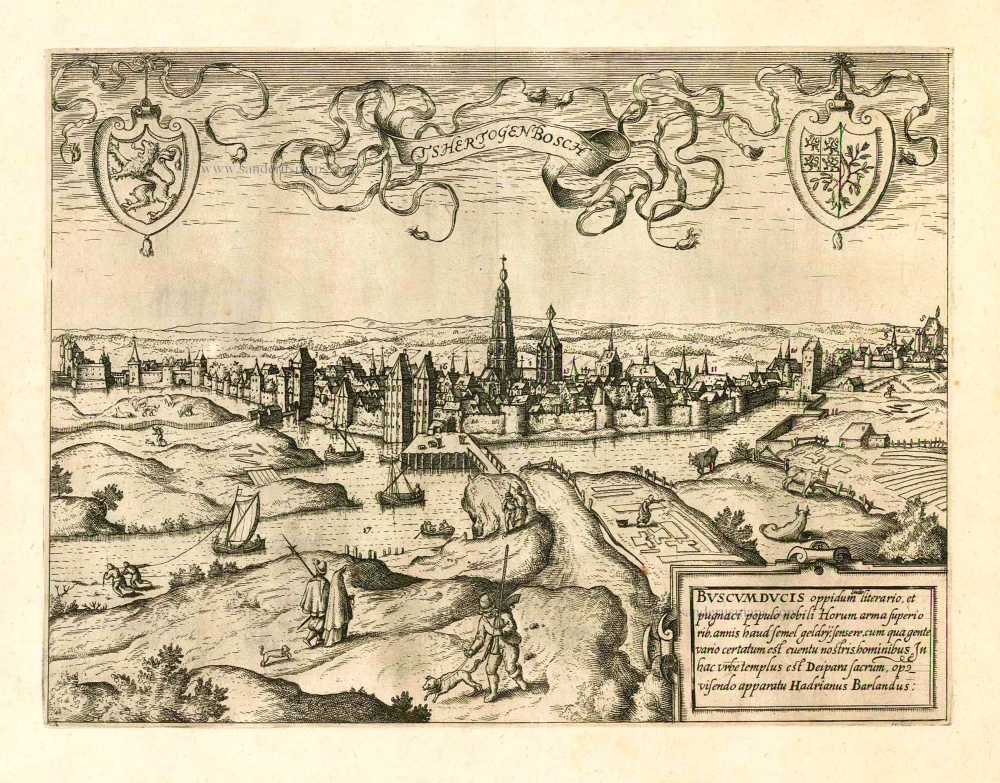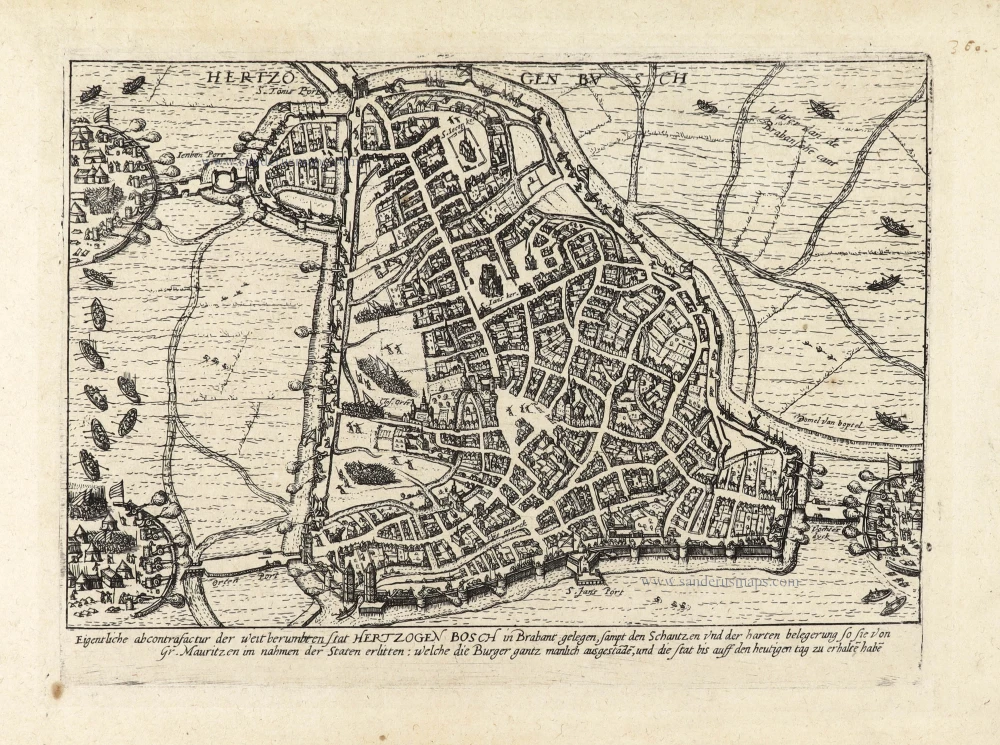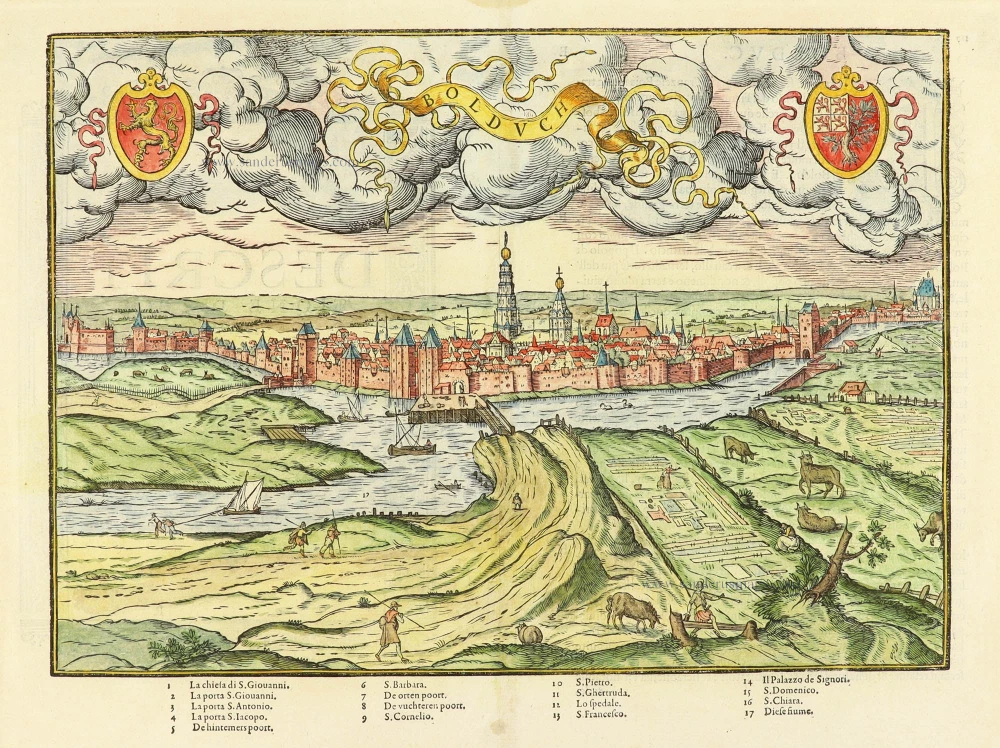s-Hertogenbosch by Braun & Hogenberg 1612
TRANSLATION CARTOUCHE TEXT: Hadrianus Barlandus. 's-Hertogenbosch, a Brabantian city famous for its school and its warlike people. In earlier times the people of Guelders felt the effect of their weapons more than once, and our troops fought against them with varying success. Here stands a church dedicated to the Mother of God, a magnificent work.
COMMENTARY BY BRAUN: "The people in 's-Hertogenbosch are naturally communicative, friendly and modest, and they are skilled in trade and handicrafts. They are leaders in spinning and weaving, and cloth worth 200,000 crowns is spun and woven here every year. The local water is of great advantage to them, for it has the natural property of making the cloth whiter than any water can. In this city there are also ver skilful cutlers who manufacture needles and pins of such high quality and in such great quantity that they are sought after in all parts of the world."
In this large-format bird's-eye plan of 's-Hertogenbosch the cathedral of St John (top) is surrounded by a green. It is one of the most important churches in the Netherlands. Initially planned as a parish church, it became the cathedral of the newly founded diocese of 's-Hertogenbosch in 1559. This plan shows the charasteristic, almost triangular Old Town, with the marketplace that also has a triangular shape, and the little Rivers Dommel and Aa with their many arms flowing around and through the city. 's-Hertogenbosch was granted a municipal charter in 1185 and in the late Middle Ages it was a market centre for farmers from the surrounding region, who traded here in linen spun from flax and cloth woven from wool. Besides having been a centre of the cloth industry, 's-Hertogenbosch was a distribution point for wine, fish and sandstone, and was of cultural significance: the painter Hieronymus Bosch lived and worked here and the humanist Georgius Macropedius, really Joris van Lanckfelt, was a teacher at the Latin school in 's-Hertogenbosch. Situated on a sandy ridge in the middle of marshes and strongly fortified, this strategically important city was for a long time considered impregnable. The Dutch Revolt in the 16th century put an end to the economic prosperity it enjoyed in the late Middle Ages. (Taschen)
Braun G. & Hogenberg F. and the Civitates Orbis Terrarum.
The Civitates Orbis Terrarum, also known as the 'Braun & Hogenberg', is a six-volume town atlas and the most excellent book of town views and plans ever published: 363 engravings, sometimes beautifully coloured. It was one of the best-selling works in the last quarter of the 16th century. Georg Braun, a skilled writer, wrote the text accompanying the plans and views on the verso. Many plates were engraved after the original drawings of a professional artist, Joris Hoefnagel (1542-1600). The first volume was published in Latin in 1572 and the sixth in 1617. Frans Hogenberg, a talented engraver, created the tables for volumes I through IV, and Simon van den Neuwel made those for volumes V and VI. Other contributors were cartographers Daniel Freese and Heinrich Rantzau, who provided valuable geographical information. Works by Jacob van Deventer, Sebastian Münster, and Johannes Stumpf were also used as references. Translations appeared in German and French, making the atlas accessible to a broader audience.
Since its original publication of volume 1 in 1572, the Civitates Orbis Terrarum has left an indelible mark on the history of cartography. Seven more editions followed the first volume in 1575, 1577, 1582, 1588, 1593, 1599, and 1612. Vol.2, initially released in 1575, saw subsequent editions in 1597 and 1612. The subsequent volumes, each a treasure trove of historical insights, graced the world in 1581, 1588, 1593, 1599, and 1606. The German translation of the first volume, a testament to its widespread appeal, debuted in 1574, followed by the French edition in 1575.
Several printers were involved: Theodor Graminaeus, Heinrich von Aich, Gottfried von Kempen, Johannis Sinniger, Bertram Buchholtz, and Peter von Brachel, all of whom worked in Cologne.
Georg Braun (1541-1622)
Georg Braun, the author of the text accompanying the plans and views in the Civitates Orbis Terrarum, was born in Cologne in 1541. After his studies in Cologne, he entered the Jesuit Order as a novice, indicating his commitment to learning and intellectual pursuits. In 1561, he obtained his bachelor's degree; in 1562, he received his Magister Artium, further demonstrating his academic achievements. Although he left the Jesuit Order, he continued his studies in theology, gaining a licentiate in theology. His theological background likely influenced the content and tone of the text in the Civitates Orbis Terrarum, adding a unique perspective to the work.
Frans Hogenberg (1535-1590)
Frans Hogenberg was a Flemish and German painter, engraver, and mapmaker. He was born in Mechelen as the son of Nicolaas Hogenberg.
By the end of the 1560s, Frans Hogenberg was employed upon Abraham Ortelius's Theatrum Orbis Terrarum, published in 1570; he is named an engraver of numerous maps. In 1568, he was banned from Antwerp by the Duke of Alva and travelled to London, where he stayed a few years before emigrating to Cologne. He immediately embarked on his two most important works, the Civitates, published in 1572 and the Geschichtsblätter, which appeared in several series from 1569 until about 1587.
Thanks to large-scale projects like the Geschichtsblätter and the Civitates, Hogenberg's social circumstances improved with each passing year. He died as a wealthy man in Cologne in 1590.
t's Hertogenbosch
Item Number: 13655 Authenticity Guarantee
Category: Antique maps > Europe > The Netherlands - Cities
Antique map of 's-Hertogenbosch by Braun & Hogenberg.
Title: t's Hertogenbosch.
Cartographer: Jacob van Deventer.
Date of the first edition: 1588.
Date of this map: 1612.
Copper engraving, printed on paper.
Size (not including margins): 340 x 470mm (13.39 x 18.5 inches).
Verso: Latin text.
Condition: Original coloured, excellent.
Condition Rating: A.
From: Liber Quartus Urbium Praecipuarum Totius Mundi. Cologne,Petrus von Brachel, 1612. (Van der Krogt 4, 41:1.4(1612))
TRANSLATION CARTOUCHE TEXT: Hadrianus Barlandus. 's-Hertogenbosch, a Brabantian city famous for its school and its warlike people. In earlier times the people of Guelders felt the effect of their weapons more than once, and our troops fought against them with varying success. Here stands a church dedicated to the Mother of God, a magnificent work.
COMMENTARY BY BRAUN: "The people in 's-Hertogenbosch are naturally communicative, friendly and modest, and they are skilled in trade and handicrafts. They are leaders in spinning and weaving, and cloth worth 200,000 crowns is spun and woven here every year. The local water is of great advantage to them, for it has the natural property of making the cloth whiter than any water can. In this city there are also ver skilful cutlers who manufacture needles and pins of such high quality and in such great quantity that they are sought after in all parts of the world."
In this large-format bird's-eye plan of 's-Hertogenbosch the cathedral of St John (top) is surrounded by a green. It is one of the most important churches in the Netherlands. Initially planned as a parish church, it became the cathedral of the newly founded diocese of 's-Hertogenbosch in 1559. This plan shows the charasteristic, almost triangular Old Town, with the marketplace that also has a triangular shape, and the little Rivers Dommel and Aa with their many arms flowing around and through the city. 's-Hertogenbosch was granted a municipal charter in 1185 and in the late Middle Ages it was a market centre for farmers from the surrounding region, who traded here in linen spun from flax and cloth woven from wool. Besides having been a centre of the cloth industry, 's-Hertogenbosch was a distribution point for wine, fish and sandstone, and was of cultural significance: the painter Hieronymus Bosch lived and worked here and the humanist Georgius Macropedius, really Joris van Lanckfelt, was a teacher at the Latin school in 's-Hertogenbosch. Situated on a sandy ridge in the middle of marshes and strongly fortified, this strategically important city was for a long time considered impregnable. The Dutch Revolt in the 16th century put an end to the economic prosperity it enjoyed in the late Middle Ages. (Taschen)
Braun G. & Hogenberg F. and the Civitates Orbis Terrarum.
The Civitates Orbis Terrarum, also known as the 'Braun & Hogenberg', is a six-volume town atlas and the most excellent book of town views and plans ever published: 363 engravings, sometimes beautifully coloured. It was one of the best-selling works in the last quarter of the 16th century. Georg Braun, a skilled writer, wrote the text accompanying the plans and views on the verso. Many plates were engraved after the original drawings of a professional artist, Joris Hoefnagel (1542-1600). The first volume was published in Latin in 1572 and the sixth in 1617. Frans Hogenberg, a talented engraver, created the tables for volumes I through IV, and Simon van den Neuwel made those for volumes V and VI. Other contributors were cartographers Daniel Freese and Heinrich Rantzau, who provided valuable geographical information. Works by Jacob van Deventer, Sebastian Münster, and Johannes Stumpf were also used as references. Translations appeared in German and French, making the atlas accessible to a broader audience.
Since its original publication of volume 1 in 1572, the Civitates Orbis Terrarum has left an indelible mark on the history of cartography. Seven more editions followed the first volume in 1575, 1577, 1582, 1588, 1593, 1599, and 1612. Vol.2, initially released in 1575, saw subsequent editions in 1597 and 1612. The subsequent volumes, each a treasure trove of historical insights, graced the world in 1581, 1588, 1593, 1599, and 1606. The German translation of the first volume, a testament to its widespread appeal, debuted in 1574, followed by the French edition in 1575.
Several printers were involved: Theodor Graminaeus, Heinrich von Aich, Gottfried von Kempen, Johannis Sinniger, Bertram Buchholtz, and Peter von Brachel, all of whom worked in Cologne.
Georg Braun (1541-1622)
Georg Braun, the author of the text accompanying the plans and views in the Civitates Orbis Terrarum, was born in Cologne in 1541. After his studies in Cologne, he entered the Jesuit Order as a novice, indicating his commitment to learning and intellectual pursuits. In 1561, he obtained his bachelor's degree; in 1562, he received his Magister Artium, further demonstrating his academic achievements. Although he left the Jesuit Order, he continued his studies in theology, gaining a licentiate in theology. His theological background likely influenced the content and tone of the text in the Civitates Orbis Terrarum, adding a unique perspective to the work.
Frans Hogenberg (1535-1590)
Frans Hogenberg was a Flemish and German painter, engraver, and mapmaker. He was born in Mechelen as the son of Nicolaas Hogenberg.
By the end of the 1560s, Frans Hogenberg was employed upon Abraham Ortelius's Theatrum Orbis Terrarum, published in 1570; he is named an engraver of numerous maps. In 1568, he was banned from Antwerp by the Duke of Alva and travelled to London, where he stayed a few years before emigrating to Cologne. He immediately embarked on his two most important works, the Civitates, published in 1572 and the Geschichtsblätter, which appeared in several series from 1569 until about 1587.
Thanks to large-scale projects like the Geschichtsblätter and the Civitates, Hogenberg's social circumstances improved with each passing year. He died as a wealthy man in Cologne in 1590.

